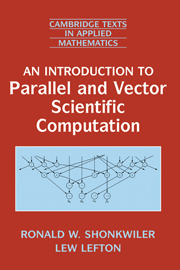Book contents
- Frontmatter
- Contents
- Preface
- PART I MACHINES AND COMPUTATION
- PART II LINEAR SYSTEMS
- 4 Building Blocks – Floating Point Numbers and Basic Linear Algebra
- 5 Direct Methods for Linear Systems and LU Decomposition
- 6 Direct Methods for Systems with Special Structure
- 7 Error Analysis and QR Decomposition
- 8 Iterative Methods for Linear Systems
- 9 Finding Eigenvalues and Eigenvectors
- PART III MONTE CARLO METHODS
- APPENDIX: PROGRAMMING EXAMPLES
- References
- Index
5 - Direct Methods for Linear Systems and LU Decomposition
Published online by Cambridge University Press: 12 December 2009
- Frontmatter
- Contents
- Preface
- PART I MACHINES AND COMPUTATION
- PART II LINEAR SYSTEMS
- 4 Building Blocks – Floating Point Numbers and Basic Linear Algebra
- 5 Direct Methods for Linear Systems and LU Decomposition
- 6 Direct Methods for Systems with Special Structure
- 7 Error Analysis and QR Decomposition
- 8 Iterative Methods for Linear Systems
- 9 Finding Eigenvalues and Eigenvectors
- PART III MONTE CARLO METHODS
- APPENDIX: PROGRAMMING EXAMPLES
- References
- Index
Summary
The problem of solving linear systems of equations is central in scientific computation. Systems of linear equations arise in many areas of science, engineering, finance, commerce, and other disciplines. They emerge directly through mathematical models in these areas or indirectly in the numerical solution of mathematical models as for example in the solution of partial differential equations. Because of the importance of linear systems, a great deal of work has gone into methods for their solution.
A system of m equations in n unknowns may be written in matrix form as Ax = b in which the coefficient matrix A is m × n, while the unknown vector x and the right-hand side b are n-dimensional. The most important case is when the coefficient matix is square, corresponding to the same number of unknowns as equations. The more general m × n case can be reduced to this.
There are two main methods for solving these systems, direct and iterative. If arithmetic were exact, a direct algorithm would solve the system exactly in a predetermined finite number of steps. In the reality of inexact computation, a direct method still stops in the same number of steps but accepts some level of numerical error. A major consideration with respect to direct methods is mitigating this error. Direct methods are typically used on moderately sized systems in which the coefficient matrix is dense, meaning most of its elements are nonzero. By contrast, iterative methods are typically used on very large, sparse systems. Iterative methods asymptotically converge to the solution and so run until the approximation is deemed acceptable.
- Type
- Chapter
- Information
- An Introduction to Parallel and Vector Scientific Computation , pp. 126 - 161Publisher: Cambridge University PressPrint publication year: 2006

